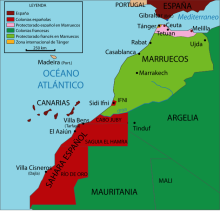Río de Oro

| Part of a series on the |
| Western Sahara conflict |
|---|
 |
| Background |
| Regions |
| Politics |
| Clashes |
| Issues |
| Peace process |
Río de Oro (Spanish for "Gold River", Arabic: وادي الذهب wādī-að-ðahab, often transliterated as Oued Edhahab), is, with Saguia el-Hamra, one of the two territories that formed the Spanish province of Spanish Sahara after 1969; it was originally taken as a Spanish colonial possession in the late 19th century. Its name seems to come from an east-west river which was supposed to have run through it formerly. The river was thought to have largely dried out - a wadi, as the name indicates - or have disappeared underground.
However, deriving from its previous name Rio do Ouro Portuguese seafarers applied it to the area, although no gold had been found there, neither in the water of the narrow gulf, probably mistaken for the river itself, nor in its neighbourhood. Obviously it goes back to those tradesmen who had got part of their merchandise paid in gold dust, in 1442, thus believing they had come across a country where gold could be found.
Occupying the southern part of Western Sahara, the territory lies between 26° to the north and 21° 20' to the south. The area is roughly 114,000 mi.2 (184,000 km²), making it approximately two-thirds of the entire territory. The former provincial capital founded by the Spanish colonizers was Villa Cisneros, while the town's name under Moroccan administration has become ad-Dakhla .
In 1975, as Spain retreated from the territory, Western Sahara was split between Mauritania and Morocco, even if this division was bitterly contested by the Polisario Front. The dividing line ran halfway through Río de Oro, with Morocco taking the northern part plus Saguia el-Hamra, and Mauritania annexing the lower third of the colony as a northern province called Tiris al-Gharbiyya (Western Tiris). Its provincial capital was already called Dakhla. After a disastrous four-year war with the Polisario, Mauritania relinquished Tiris al-Gharbiyya, withdrew from Western Sahara, and left Morocco and the Polisario as the sole protagonists in the conflict, which is still on-going today.
This area is today divided by the Moroccan military berm, with Morocco occupying the parts to the west of it, and the Polisario Front-held Free Zone, under the control of the Sahrawi Arab Democratic Republic to the east. These zones are temporary divisions negotiated as a part of the MINURSO ceasefire[1].
References
